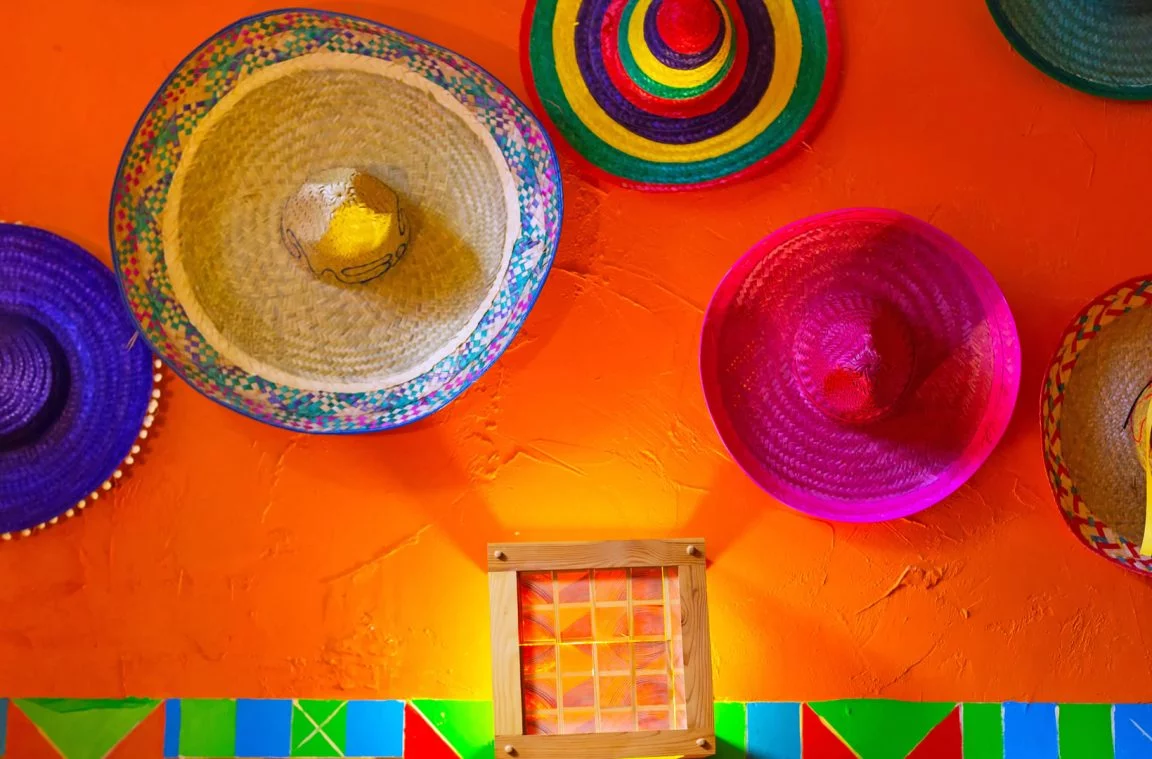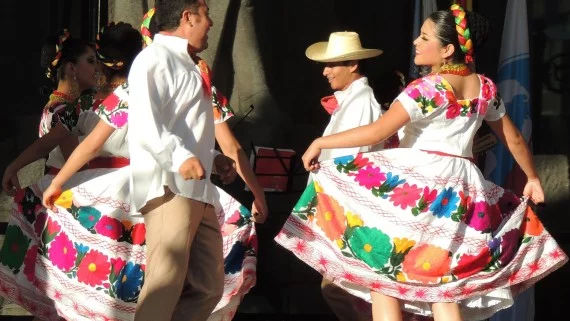The typical costumes of Mexico are the result of a mix between indigenous and Spanish culture, as well as vestiges of the Indians, Aztecs, Mayans and others. indigenous groups ancestral. The typical clothes represent not only the culture of the country, but the habits of the more than 60 million inhabitants that Mexico has.
Below you have an index with all the points that we are going to deal with in this article.
Article Index
- 1.
- 2.
- 3.
- 4.
- 5.
- 6.
- 7.
- 8.
- 9.
- 10.
- 11.
- 12.
Aguascalientes
Aguascalientes is a state of Mexico in which the National Fair of San Marcos, which is held annually between the months of April and May.
In it, contests are held that reward the best costume and, therefore, the costumes that are seen at this party are the most elaborate, colorful and striking. The women's costumes stand out, as they are the ones that spend the most time and those who participate in these contests.
Although you can find the most varied costumes, the most typical costume was designed by Jorge Campos Espino and wore a great variety of ornaments, which means that none of these dresses lack a great variety of drawings that represent from animals to fruits, all of them always made by hand.
The women's suit always has a high neck, wide sleeves at the shoulders and is very tight at the waist.
Chiapas
The most typical costume of Chiapas is that of Chiapas, which originally comes from the Mexican municipality of Chiapa de Corzo. It is believed that the costume, which consists of colorful flowers on a black or dark background, was originally designed as a means through which to represent the jungle and its fascinating flora, in which colors stand out.
The suit consists of a satin blouse with a semi-circular neckline that leaves the shoulders exposed. The lower part, the skirt, is all embroidered with colorful flowers, among which orange, pink, blue and white predominate.
For flower embroidery, silk thread is used, which is why the production process is long-lasting and requires a lot of patience. It is also typical quechquemel, a kind of blanket or poncho that is placed on the upper part of the body and through which the head is inserted.
It also highlights the fabric and the motifs of the traditional wedding dress from the municipality of Zinacantán, also located in Chiapas, which can be seen in the photo shown below.
Chichén Itzá
The Chichen Itzá archaeological site is located in the Yucatan peninsula and is part of the indigenous legacy that has survived to this day. For this reason, the inhabitants of the surroundings have indigenous customs result of the tribal culture that has been preserved in the area.
Thus, clothing is characterized by suits in which there is no lack of flower embroidery with a wide palette of colors on white backgrounds. Women's dresses can be found in many colors, but they always stand out for one main feature: they go cinched at the waist.
Guadalajara
In the city of Guadalajara (Jalisco, Mexico), both men's and women's suits are called charro suit, although this name is known throughout the country because these costumes have been around the world.
As for the woman's, it consists of a tangle of blanket whose length reaches almost the ankles. The skirt is covered with embroidery made with the cross stitch technique in a linear way and with threads of a great variety of colors.
The men's one can be the typical mariachi, which is black, adds some color details and includes a charro hatOr it can include a kind of poncho made of sheep, llama, alpaca or other animal wool.
This poncho has an opening in the center through which the head is inserted and it usually has thick stripes or other designs of different colors. In its origins, poncho, which today is used throughout Latin America, was used by Indians, mestizos, whites, gauchos, etc. and it is still preserved today.
Hidalgo
In the Mexican state of Hidalgo, three regions can be distinguished in which a cultural identity predominates that stands out for having its own traditions and customs, among which clothing stands out.
Thus, we find three differentiated regions: Sierra Tepehua, Mezquital Valley and Huasteca.
The Tepehua are an ethnic group whose traditional clothing is characterized by being designed for a temperate climate, so it is a blanket that almost always includes embroidery in red, although green thread can also be used.
As for the Mezquital Valley, the outfit is quite similar to that of the Sierra Tepehua region, since it is also made of blanket, but the embroidery it wears is called pickled and it can be found made of black, red, blue, green yarn, etc.
This embroidery represents indigenous values such as the Nahui Ollin or the Xinicuilli. Finally, the Huasteca region comprises northern Veracruz, southern Tamaulipas, parts of San Luis Potosí and Hidalgo, and the Sierra Gorda de Querétaro.
In the latter, a hot and humid climate predominates at the same time, so the typical costume consists of a white short-sleeved blouse on which embroideries are woven in the shape of flowers in an infinity of colors.
Michoacán
The culture of the Mexican state of Michoacán is known as tarascan culture or purépache, which already existed in pre-Columbian times, around 1200 BC
Thus, the current Purépecha people have specific indigenous traditions, among which there is no lack of typical clothing, the result of the various artisan activities carried out by the inhabitants of this community.
Special mention deserves the women's suit, which is made up of a skirt and a shirt. As for skirts, there are two types:
- Altar cloth: consists of a kind of rectangular canvas made with wool and handwoven. Its amplitude served in its origins to shelter during cold winter nights, hence the name of altar cloth. During the day, this skirt is used as a skirt and is fastened at the waist with a girdle.
- Zagalejo: it is also made of wool and is distinguished from the sabanilla because on the upper part it has a strip of strong colored cotton, which contrasts with the strip on the lower part, which is light in color.
The shirts can be found of different types, although perhaps the most common is the one that consists of a shirt that is folded on the chest and back, and is embroidered with white or colored details.
Nayarit
The Coras and Huichol Indians have maintained their tradition for thousands of years and, currently, the typical male costume of Nayarit is that of the Huichol, derived from the creative culture and the characteristic artisan skills of this indigenous community.
Huichol women are known to be the best weavers in Mexico, mainly for their artistic skills and their manual dexterity resulting in extraordinary wool garments with unique designs.
The men's suit is characterized by the use of a white blanket and a shirt that has the lower part of the sleeves open and is embroidered with symmetrical designs of different colors.
As for the female costume, it consists of a blouse of a single color that includes exterior and interior naguas and on which a cloak that covers the head and beaded necklaces is added.
Oaxaca
Although all the typical costumes of Mexico are characterized by being very colorful, perhaps the clothing used by the women of Oaxaca is the most colorful of all.
In these dresses a mix of indigenous traditions and colonial elaboration techniques, such as bobbin lace or flamenco holanes, among others.
In the District of Jamiltepec specifically, the dresses have a wide range of indigenous symbols, such as the Sun, the stars and other geometric shapes that often resemble spiders or lizards.
The typical skirt or roll is called poshuanco.
Puebla
The typical costume par excellence of women in the state of Puebla (Mexico) is known by the name of Chinese Poblana, which is composed, in the upper part, of a low-cut white blouse, so that part of the neck and chest is shown.
Its color is white and in it colored embroidery is woven that is usually shaped like a flower. At the bottom, the woman wears a skirt that goes by the name of castor, due to the fabric with which it is made.
Said skirt, which can also be called zagalejo It consists of two layers: first, the top layer, which measures about 25 cm and is made of calico or green silk (known as court); secondly, the bottom layer, which is covered with sequin patterns and reaches the ankles.
Saltillo
The city of Saltillo is the capital of the state of Coahuila de Zaragoza (Mexico) and whose typical male costume is known by the name of serape o hunchback.
It consists of a kind of poncho that has been used since its origins to shelter, since it is made of cotton fiber or sheep wool. The thread, as in almost all typical Mexican garments, is of multiple colors and the designs that are woven are unique and open to the imagination.
As for the female attire, it is characterized by embroidered and frayed blouses They can be found in countless colors and embroidered with flowers or other geometric shapes.
Yucatan
The typical female costume of Yucatan is called internal for the three pieces that compose it: fustán, huipil and doublet. The fustan (called pic in Mayan) it is the lower part and consists of a kind of skirt fitted at the waist and reaching the feet.
This skirt dates back to the time of Mayan women. The doublet is the square neck that is placed over the huipil, which is the white dress itself. In addition, this suit is complemented by a kind of shawl that is called shawl of Santa Maria or with a filigree rosary, handcrafted by Yuctaecan goldsmiths.
Veracruz
The typical costume of Veracruz (Mexico) stands out because it is dominated by white, either in the case of male or female clothing, and is called jarocho suit.
The women's dress has a long and wide skirt that covers the ankles and, on the neutral white color, some lace or embroidery in various colors are sewn. An apron or apron is placed on this skirt, which is usually black, maroon or burgundy and the fabric is velvet.
This apron can also have some embroidered details in different colors. The top is the same color and may or may not have sleeves. Finally, it also includes a silk shawl that is usually yellow with white details and may have fringes or other decorative elements.
The men's outfit, meanwhile, has white pants and a shirt also of this color, which must always have four pockets (called scholarships in the area) and four tucks or folds in front and another six behind.
This article has been shared 474 times. We have spent many hours collecting this information. If you liked it, share it, please:














